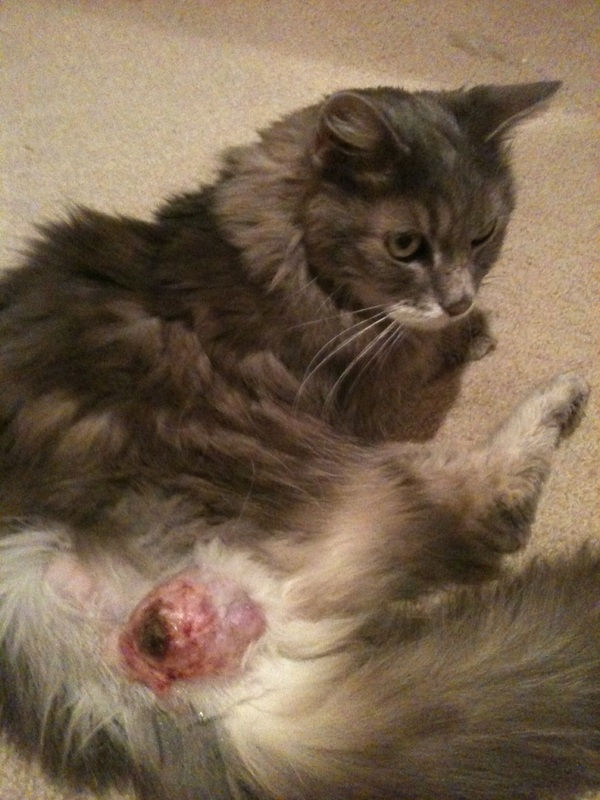Immunization Awareness Month: Feline Vaccines

Since it is immunization awareness month, I thought we could talk a little about cat vaccines this week. So, does anyone know what FVRCP is?
Well, if you answered feline viral rhinotracheitis, calicivirus, and panleukopenia, you win the prize! Colloquially, FVRCP is known as “feline distemper.” This is considered one of the core vaccines by the American Association of Feline Practitioners, and kittens should be given this vaccine every 3-4 weeks beginning at 6 weeks until they reach 16-20 weeks of age. Older kittens that are greater than 16 weeks and adult cats should be given a 2-dose series. All cats should be boostered one year later. Pets at low risk of exposure should then be vaccinated every 3 years, and cats at higher risk of exposure (show cats, outdoor cats, cattery cats) should be vaccinated more frequently, usually every 2 years.

Now that we have talked about the frequency of administration, you are probably wondering what this vaccine is actually preventing. Feline viral rhinotracheitis is a herpes virus, and it causes upper respiratory infections, including fever, sneezing, nasal discharge, conjunctivitis, and corneal ulcers. This virus is highly contagious, and it can recur throughout a cat’s life just like a cold sore can in people. The vaccine is moderately effective in preventing disease, and it is very effective in reducing clinical signs.
Calicivirus is another component of the upper respiratory infection that cats can get. This virus most frequently causes mouth pain and oral ulcers, but it can also be associated with joint pain and lameness.

Panleukopenia is a parvovirus, and the canine parvovirus mutated from the feline virus. This virus causes an extremely low white blood cell count, vomiting, diarrhea, and dehydration. This virus can cause death in 25-50% of affected kittens. If the kittens are infected in utero, they can have neurological signs such as having a wide-based stance, intention tremors when moving, and seizures.
Rabies is another important vaccine. The AAFP does not consider this a core vaccine, but we live in a rabies endemic state. Therefore, it is a core vaccine for our cats. I won’t spend much time talking about rabies since you can go back to last week’s blog for more information about this disease. However, I will tell you that there are 2 basic types of rabies vaccines available. There are inactivated products, which contain a killed virus. The virus is then unable to replicate and cause disease, but the body can mount an immune response against the virus. There are also recombinant products, and these only contain a portion of the virus so that they are unable to cause disease. With rabies vaccines, kittens should be given a single dose after 12 weeks of age. The vaccine should then be boostered in one year, and boosters should then be given yearly to every 3 years, depending upon the product used.
Feline leukemia virus is a non-core vaccine, and FeLV can cause immune disorders/immunosuppression, anemia, and even cancer. This is a virus that is most often associated with close contact, such as social grooming. The AAFP recommends that kittens and adults be given a 2-dose series with a booster dose one year later. Cats that go outside frequently or multi-cat household with frequent additions should be given regular boosters, but cats at low risk of exposure may not require any boosters after the first one. All cats should be tested for FeLV prior to receiving the vaccine because the vaccine will not provide protection in cats that are already exposed.
Feline immunodeficiency virus (FIV) is another non-core vaccine. Although all cats should be tested for this virus, only outdoor cats should be considered as candidates for this vaccine.

Before we leave feline vaccines, we need to talk briefly about injection site sarcomas. In the early 1990s, an increase in sarcomas was seen in cats at their injection sites. Initially, the cancers were believed to be associated with inactivated rabies vaccines and FeLV vaccines, but we have subsequently learned that there is no association between the type of vaccine, brand of product, or use of inactivated virus versus modified live virus. Really, the risk of these reactions is low, occurring in less than 1/10,000 doses of vaccine administered. However, these injection site sarcomas are horrible cancers, and we want to decrease the risk of developing these cancers since they are difficult to treat, requiring combinations of surgery, chemotherapy, and radiation therapy. There are several things that can be done to decrease the risk. First, we want to vaccinate wisely, taking into consideration the potential exposure to infectious diseases. Second, we want to administer the vaccines at appropriate intervals, giving the vaccines more frequently to cats at higher risk of exposure. Third, vaccines should be given subcutaneously as “lumps” are easier to detect in the subcutaneous tissue than muscle. Fourth, vaccines should be administered on limbs, and they should be given below elbows and knees. This allows an amputation to obtain clean margins if an injection site cancer develops. Fifth, if a “lump” develops, it should be removed if it persists longer than 3 months, becomes larger than 2 cm in diameter, or increases in size more than 1 month after vaccine administration.

Well, I hope this helps clear the waters about feline vaccines. Please talk to your regular veterinarian about designing a protocol that works to protect your feline friends!




















